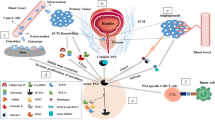Summary
Serum amyloid A (SAA) and acid phosphatase (AcP) levels were determined in serial serum samples of 35 patients in different stages of dissemination and correlated with activity of carcinoma of the prostate. Up to 500-fold increases in SAA level were detected during active periods of cancer with a decrease towards the normal range in remission, in comparison with a 10-fold increase of AcP. The correlation between these two parameters was highly significant (P<0.001), but while SAA shows 100% sensivity during the active stage, AcP shows only 85% sensitivity. It is suggested that althouth SAA is not a specific marker for any particular illness, due to its characteristic pattern of change in malignant diseases and its high sensitivity, it represents a useful biochemical parameter for the assessment of the activity of the disease to monitor response to therapy during follow-up.
Similar content being viewed by others
References
Baumal R, Sklar S, Wilson B, Laskov R (1978) Casein-induced murine amyloidosis: amyloidogenesis in vitro by monolayer spleen explants of casein-infected mice. Lab Invest 36:632
Bausserman LL, Herbert PN, McAdam KRWJ (1980) Heterogeneity of human serum amyloid A protein. J Exp Med 152:641
Benditt EP, Erikson N (1977) Amyloid protein SAA is associated with high density lipoprotein from human serum. Proc Natl Acad Sci USA 74:4025
Benson MD, Aldo-Benson M (1979) Effect of purified protein SAA on immune response in vitro: mechanisms of suppression. J Immunol 122:2077
Benson MD, Kleiner E (1980) Synthesis and secretion of serum amyloid protein A (SAA) by hepatocytes in mice treated with casein. J Immunol 124:495
Bruce AW, Mahan DE, Morales A, Clark AF, Belville WD (1979) An objective look at acid phosphatase determinations. Br J Urol 51:213
Catalona WJ, Menon M (1981) New screening and diagnostic tests for prostate cancer and immunologic assessment. Urology (Suppl) 17:61
Fair WR, Catalona WJ, Ratliff TR, Hector WDW (1980) Tumor markers for prostatic carcinoma: PAP and CK-BB. Presented at the Annual Meeting American Urological Assoc. San Francisco, Cal
Fair WR, Kadmon D (1983) Carcinoma of the prostate: Diagnosis and staging. Current status and future prospects. World J Urol 1:3
Gutman AB, Gutman EB (1938) An “acid” phosphatase occurring in the serum of patients with metastasizing carcinoma of the prostate gland. J Clin Invest 17:473
Hennebery MD, Engel G, Grayhack JT (1979) Acid Phosphatase. Urol Clin North Am 6:629
Hunter WM, Greenwood FC (1962) Preparation of iodine-131 labelled human growth hormone of high specific activity. Nature 194:945
Kushner I (1982) The phenomenon of the acute phase response. In: Volanakis JE, Geverz H (eds) Annals of the NY Academy of Science, Vol 389, p39
Levin M, Pras M, Franklin EC (1973) Immunologic studies of the major non-immunoglobulin protein of amyloid. I. Identification and partial characterization of a related serum component. J Exp Med 138:373
Linder E, Lehto VP, Vintanen I, Stenman J, Natvig JB (1977) Localization of amyloid related serum protein SAA-like material to intermediate filaments of cultured human embryonal fibroblasts. J Exp Med 146:1158
Pontes JE (1981) New assays for prostatic acid phosphatase and alkaline phosphatase isoenzymes. Urology (Suppl) 17:38
Rosenthal CJ, Franklin EC (1975) Variation with age and disease of an amyloid A protein-related serum component. J Clin Invest 55:746
Rosenthal CJ, Sullivan L (1978) Serum amyloid A. Evidence for its origin in polymorphonuclear leukocytes. J Clin Invest 62:1181
Rosenthal CJ, Sullivan LM (1979) Serum amyloid A to monitor cancer dissemination. Ann Int Med 91:383
Sarov I, Shainkin-Kestenbaum R, Zimlichman S, Winikoff Y, Chaimovitz C, Pras M (1982) Serum amyloid A levels in patients with infection. J Infect Dis 146:443
Selinger MJ, McAdam KRWJ, Kaplan MM, Sipe JD, Vogen SN, Rosenstreich DL (1980) Monokine induced synthesis of serum amyloid A protein by hepatocytes. Nature 285:498
Shainkin-Kestenbaum R, Zimlichman S, Winikoff Y, Pras M, Chaimovitz C, Sarov I (1982) Serum amyloid A in viral infection. Clin Exp Immunol 50:503
Sipe JD, Vogel SN, Ryan JL, McAdam KRWJ, Rosenstreich DL (1979) Detection of a mediator derived from endotoxinstimulated macrophages that induced the acute phase serum amyloid A response in mice. J Exp Med 150:597
Author information
Authors and Affiliations
Additional information
The work was supported by a grant from the Israel Academy of Science-Basic Research
Rights and permissions
About this article
Cite this article
Kaneti, J., Winikoff, Y., Zimlichman, S. et al. Importance of serum amyloid A (SAA) level in monitoring disease activity and response to therapy in patients with prostate cancer. Urol. Res. 12, 239–241 (1984). https://doi.org/10.1007/BF00256147
Accepted:
Issue Date:
DOI: https://doi.org/10.1007/BF00256147




